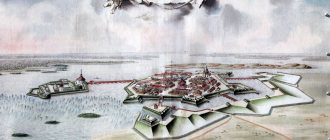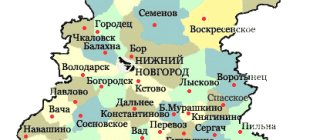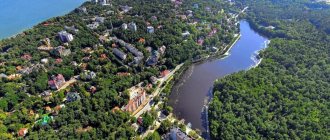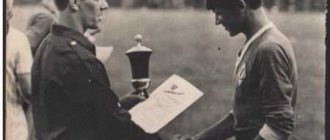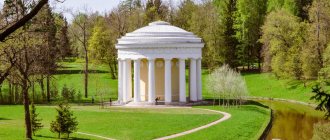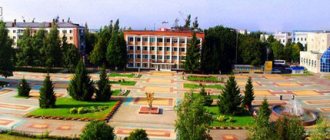Pinery
| Coat of arms of Sosnovy Bor | ||
| A country | Russia | |
| Region | Leningrad region | |
| Square | 72 km² | |
| Population • Number • Density | 66,700,926 people/km² | |
| Telephone code | +7-81369 | |
| Official site | sbor.ru | |
| Map of Sosnovy Bor from Google | ||
Content
- 1 A little about Sosnovy Bor
- 2 Districts of Sosnovy Bor
- 3 How to get to Sosnovy Bor 3.1 by plane
- 3.2 by train
- 3.3 by bus
- 3.4 by car
- 3.5 on the ship
Greetings from the heads of Sosnovy Bor District
Mikhail Vasilyevich VORONKOV, head of administration and head of Sosnovoborsky urban district
Dear friends!
On behalf of all residents of Sosnovy Bor, we are pleased to welcome you to the main page of the Sosnovy Bor urban district section on the website of the Leningrad Regional News Agency.
Our city is one of the youngest in North-West Russia. It was built as an atomic city, a satellite city of the Leningrad nuclear power plant.
Today Sosnovy Bor is the Northwestern scientific and industrial center of nuclear energy of the Russian Federation, and is also considered one of the most beautiful and comfortable cities in Russia.
On these pages you can get to know the life of our rapidly developing city, its past and present, the people living here, get information about the development of our economy, social sphere, projects in the field of education, healthcare, and culture.
Head of Administration and Head of Sosnovoborsky Urban District Mikhail VORONKOV
[edit] Museums in Sosnovy Bor
- City Museum of Glory
Address: Leningrad region, Lomonosov district, Sosnovy Bor, Afanasyeva street, 50 Telephone: +7(81369)6-17-73, Opening hours: 10:00-17:00 Tuesday to Friday, 12:00-17:00 on Saturdays and Sundays Tickets: free Description: memorial complex to the defenders, Ustinsky memorial.
- Sosnovy Bor Art Museum of Contemporary Art
Address: Leningrad region, Lomonosov district, Sosnovy Bor, Leningradskaya street, 56-A Telephone: +7(81369)2-38-93, +7(81369)2-90-52 Opening hours: Tickets: Description:
- Museum of Military Glory of Secondary School No. 3
Address: Leningrad region, Lomonosov district, Sosnovy Bor, Malaya Zemlya street, 5 Telephone: +7(81369)4-39-41 Opening hours: Tickets: Description:
general information
Heraldic description of the coat of arms of the city of Sosnovy Bor:
“In a field divided into four azure and green, there is a silver belt longitudinally divided by a narrow azure stripe (thread), at the top it is walled and jagged in accordance with the shield, at the bottom it is wavy, accompanied in each of the azure quarters of the field by a pair of silver fish in a column.
In the first green quarter there is a golden rhomboidal through octafoil, the odd leaves of which are smaller than the even ones, having a golden bezant in the middle and accompanied at the head by the same radial crown with three visible teeth and two short ones, and in the second green part - a golden castle with a green arch, o two towers with pointed roofs and with the same roof in the middle, above which there is a spire, which castle is accompanied by an abstract overturned rafters connected at the ends with two shingles.”
The coat of arms unites in symbolic images the unity and continuity of the historical past and the present on the land of the ancient principality of Izhora, on which the city of power engineers Sosnovy Bor, a border city on the maritime borders of North-West Russia, was built.
This is expressed in the fact that the main figure of the coat of arms is based on a fortress battlement - a heraldic image from the coat of arms of the Principality of Izhora (approved on March 3, 1730). The wavy silver stream is the border of the sea borders in the Baltic.
The golden “energy crown” above the symbol of the atomic nucleus means the energy of the peaceful atom and the Leningrad Nuclear Power Plant as the first-born among the giants of nuclear energy. The golden symbols of the city are a building element characteristic of the city’s layout and the children’s play complex “Andersengrad”, an architectural monument of the twentieth century as the main attraction of the city .
The colors of the coat of arms symbolize peace, purity, environmentalism, prosperity and hope.
Routes on the map of Sosnovy Bor. Transport infrastructure
The city's infrastructure developed in the attractive conditions of the location of the Lomonosov district. Transport connections formed by the existing, constantly developing ports of Vyborg, Primorsk, Ermilovskaya Bay, transport hubs of the Kengisep region have created promising opportunities for the “Russian Gateway to Europe”.
European transport corridor No. 9 was developed due to the favorable location of St. Petersburg (80 km).
You can get to the city by the Petersburg-Weimarn railway line (to the Kapiche station).
Design documentation has been developed for the construction of a new highway (currently the A-121 highway is heavily congested), connecting the satellite city with the main ring road of St. Petersburg. Its length will be about 50 km. The construction of a modern logistics center in the port of Ust-Luga is actively underway.
Economics [edit]
Industry[edit]
Sosnovy Bor is known for its research institutes and construction industry. There are about five hundred large, medium and small enterprises in the city. In 2005, investments in working capital increased by 15%.
The most famous organizations of Sosnovy Bor include:
- Leningrad Nuclear Power Plant, which provides urban heat supply; [12]
- Aleksandrovsky Scientific Research Technological Institute is a state research institution primarily engaged in the development and testing of nuclear ships and submarine power plants; [13]
- Nuclear waste disposal facility: branch of the state enterprise “Russian Radioactive Waste” (“RosRAO”); [14]
- A former branch of the State Optical Institute, now a separate “Research Institute for Integrated Testing of Optoelectronic Devices and Systems.”
Transport[edit]
Kalishche railway station
Sosnovy Bor is located on the railway connecting the Baltic Station of St. Petersburg with Weimarn. The city has two railway stations, the Kalishche railway station and the 80 km railway platform. Both are served by suburban services from St. Petersburg. There is no passenger service west of Kalishche.
The city is connected by road to St. Petersburg via Lebyazhye and is included in a dense road network south of Sosnovy Bor, which, in particular, provides access to Kingisepp and Volosovo.
Links[edit]
Notes[edit]
- ^ abcde Area Law No. 32-oz.
- ^ a b c Science cities: Sosnovy Bor (in Russian). Federal State Budgetary Institution Research Institute RINKCE. Retrieved March 18, 2013.
- ^ a b Federal State Statistics Service (2011). “All-Russian Population Census 2010. Volume 1" [All-Russian Population Census 2010, vol. 1]. All-Russian Population Census 2010 [All-Russian Population Census 2010]
. Federal State Statistics Service. - "26. The size of the permanent population of the Russian Federation by municipalities as of January 1, 2021". Federal State Statistics Service. Retrieved January 23, 2021.
- ^ abc Provincial Law No. 22-oz.
- "On the Calculation of Time". Official Internet portal of legal information
. June 3, 2011. Retrieved January 19, 2021. - Post office. Information and computing center of OASU RPO. ( Post office
).
Search for postal service objects ( postal Search for objects
) (in Russian) - Leningrad region (in Russian). Russian telephone codes. Retrieved March 22, 2013.
- ↑
Federal State Statistics Service of Russia (May 21, 2004).
“The population of Russia, the constituent entities of the Russian Federation as part of federal districts, urban settlements, settlements, settlements is 3 thousand or more people” [Population of Russia, its federal districts, federal districts, districts Urban settlements, rural settlements - administrative centers and rural settlements with a population of over 3,000] (XLS). All-Russian Population Census 2002
. - “All-Union Population Census of 1989. The current population of union and autonomous republics, autonomous regions and districts, territories, negative phenomena, urban settlements and rural district centers” [All-Union Population Census of 1989: current population of union and autonomous republics, Autonomous regions and districts , territories, regions, districts, towns and villages performing the functions of district administrative centers. All-Union Population Census of 1989 [All-Union Population Census of 1989]
.
Institute of Demography of the National Research University: Higher School of Economics [Institute of Demography of the National Research University: Higher School of Economics]. 1989 - via Demoscope Weekly
. - Oranienbaumsky district (Aug. 1927 - Feb. 1948), Lomonosovsky district (Feb. 1948 - Feb. 196Z, Jan. 1965) (in Russian). System of classifiers of executive bodies of state power of St. Petersburg. Retrieved March 13, 2013.
- "Leningrad 2nd plant begins to provide centralized heat supply". World nuclear news. December 2, 2021. Retrieved December 3, 2021.
- NITI im. A.P. Alexandrova (in Russian). NITI im. A.P. Alexandrova. Retrieved March 24, 2013.
- Northwestern Territorial District (in Russian). FSUE "RosRAO". Archived from the original on April 26, 2012. Retrieved March 24, 2013.
Sources [edit]
- Legislative Assembly of the Leningrad Region. Regional Law No. 32-oz of June 15, 2010 “On the administrative-territorial structure of the Leningrad region and the procedure for changing it,” as amended. Regional Law No. 23-oz dated May 8, 2014 “On the merger of municipalities” Primorskoye urban settlement of the Vyborg district of the Leningrad region and Glebychevskoye rural settlement of the Vyborg district of the Leningrad region and on amendments to certain Regional laws. Came into force on the date of official publication. Published: “Vesti”, No. 112, June 23, 2010 (Legislative Assembly of the Leningrad Region. Regional Law of June 15, 2010 No. 32-oz “ On the administrative-territorial structure of the Leningrad Region and the procedure for changing it”
, As amended by the Regional Law dated 05/08/2014 No. 23-oz.
On the annexation of the municipalities "Urban settlement Primorskoye" in the Vyborg district of the Leningrad region and the "Glebychevskoye rural settlement" in the Vyborg district of the Leningrad region and on amendments to various regional laws
. Valid from the date of official publication.) . - Legislative Assembly of the Leningrad Region. Regional Law No. 22-oz of March 31, 2005 “On establishing the boundaries of the municipal formation of Sosnovoborsky Urban District,” as amended. Regional Law No. 17-oz dated May 6, 2010 “On amendments to some regional laws in connection with the adoption of the federal law “On amendments to certain legislative acts of the Russian Federation in connection with improving the organization of local self-government””. Came into force 10 days from the date of official publication (May 14, 2005). Published: “Bulletin of the Government of the Leningrad Region”, No. 15, May 4, 2005 (Legislative Assembly of the Leningrad Region. Regional Law of March 31, 2005 No. 22-oz “ On establishing the boundaries of the municipal formation of the Sosnovoborsky urban district”).
As amended by the Regional Law of May 6, 2010 No. 17-oz “
On amendments to various laws of the region in connection with the adoption of the Federal Law “On amendments to certain legislative acts of the Russian Federation in order to improve the organization of local self-government.”
-Government " . Valid after 10 days from the date of official publication (May 14, 2005).
History[edit]
It was founded in 1958 as an urban settlement serving the Leningrad Nuclear Power Plant, and received the status of an urban settlement on December 10, 1958. [11] At that time it was part of the Lomonosovsky district of the Leningrad region. On April 19, 1973, Sosnovy Bor received city status and became a city of regional significance, after which it ceased to be part of the Lomonosovsky district. [2]
Chronology[edit]
| In this section do not cite any sources . |
- 1958 - Sosnovy Bor was founded.
- 1961 A branch of the Leningrad special-purpose plant “Radon” was created. Today it is a state corporation for the collection, processing and long-term storage of radioactive waste.
- 1962 The State Station for Testing Marine Nuclear Power Plants was created as a branch of the Kurchatov Institute of Atomic Energy (IAE). In 1966 it became the Scientific Research Technological Institute (NITI).
- 1963 A branch of the State Optical Institute named after. S.I. Vavilova.
- 1966 The Northern Construction Directorate, SUS, was created. His main goal was the construction of the Leningrad Nuclear Power Plant.
- On April 19, 1973, Sosnovy Bor was given city status. This date is now a city holiday.
- December 23, 1973 The first reactor of the Leningrad Nuclear Power Plant produced its first power.
- 1981 Launch of the fourth LNPP reactor. Leningrad NPP became the world's largest nuclear power plant (4 GW)
- 1996 First mayor elected.
Fixed line operators rn. Vyborg
| Numbers | Operator |
| 813-7800000 — 813-7809999 | PJSC Rostelecom |
| 813-7810000 — 813-7810009 | LLC "KTT" |
| 813-7820000 — 813-7842299 | PJSC Rostelecom |
| 813-7842300 — 813-7842499 | LLC "KTT" |
| 813-7842500 — 813-7846499 | PJSC Rostelecom |
| 813-7846500 — 813-7846699 | LLC "KTT" |
| 813-7846700 — 813-7855799 | PJSC Rostelecom |
| 813-7855800 — 813-7855899 | LLC "LUKOIL-INFORM" |
| 813-7855900 — 813-7858999 | PJSC Rostelecom |
| 813-7859000 — 813-7859099 | LLC "LUKOIL-INFORM" |
| 813-7859100 — 813-7863059 | PJSC Rostelecom |
| 813-7863060 — 813-7863099 | PJSC MegaFon |
| 813-7863100 — 813-7869089 | PJSC Rostelecom |
| 813-7869090 — 813-7869099 | PJSC MegaFon |
| 813-7869100 — 813-7869899 | PJSC Rostelecom |
| 813-7869900 — 813-7869999 | LLC "LUKOIL-INFORM" |
| 813-7870000 — 813-7878699 | PJSC Rostelecom |
| 813-7878700 — 813-7878799 | JSC Svyaztransneft |
| 813-7878800 — 813-7878899 | PJSC Rostelecom |
| 813-7878900 — 813-7878999 | JSC Svyaztransneft |
| 813-7879000 — 813-7889999 | PJSC Rostelecom |
| 813-7890000 — 813-7890399 | PJSC "Vympel-Communications" |
| 813-7890400 — 813-7890499 | JSC "ER-Telecom Holding" |
| 813-7890500 — 813-7890999 | PJSC "Vympel-Communications" |
| 813-7891000 — 813-7893399 | PJSC Rostelecom |
| 813-7893400 — 813-7893599 | OJSC "SZEUK" |
| 813-7893600 — 813-7893999 | PJSC Rostelecom |
| 813-7894000 — 813-7894999 | PJSC "Vympel-Communications" |
| 813-7895000 — 813-7895602 | PJSC MegaFon |
| 813-7895603 — 813-7895603 | LLC "Net By Net Holding" |
| 813-7895604 — 813-7895621 | PJSC MegaFon |
| 813-7895622 — 813-7895622 | LLC "Net By Net Holding" |
| 813-7895623 — 813-7895689 | PJSC MegaFon |
| 813-7895690 — 813-7895690 | LLC "Net By Net Holding" |
| 813-7895691 — 813-7895999 | PJSC MegaFon |
| 813-7896000 — 813-7896099 | JSC Russian Railways |
| 813-7896100 — 813-7896112 | PJSC Rostelecom |
| 813-7896113 — 813-7896113 | JSC Russian Railways |
| 813-7896114 — 813-7896199 | PJSC Rostelecom |
| 813-7896200 — 813-7896999 | JSC Russian Railways |
| 813-7897000 — 813-7897999 | PJSC "Vympel-Communications" |
| 813-7898000 — 813-7898999 | PJSC MegaFon |
| 813-7899000 — 813-7899399 | PJSC Rostelecom |
| 813-7899400 — 813-7899499 | JSC Severen-Telecom |
| 813-7899500 — 813-7899999 | PJSC Rostelecom |
CITIES
Vyborg (g) 81378 Vysotsk (g) 81378 Kamennogorsk (g) 81378 Primorsk (g) 81378 Svetogorsk (g) 81378
Vyborg (g) 81378 Vysotsk (g) 81378 Kamennogorsk (g) 81378 Primorsk (g) 81378 Svetogorsk (g) 81378
Sights of the city of Sosnovy Bor
The youngest city in the Leningrad region, despite its age, has many interesting places on its streets and surroundings. Among them are the following attractions:
- Museums: naval, modern art, history of Vladimir Antoninov.
- Temples: Cathedral of the Icon of the Mother of God "Burning Bush", St. Nicholas the Wonderworker, Alexander Nevsky, chapel, St. Panteleimon. The churches of St. Seraphim of Sarov and St. Lazarus are being designed and built.
- A children's center that has become the pearl of the city. "Andersengrad".
- Koporye Fortress, famous fort "Red Hill"
- Petrov's merchant house , Elevatsiya ranch.
A map of Sosnovy Bor with houses helps you quickly find any attraction.
Coats of arms of municipal districts of the Leningrad region
Boksitogorsk municipal district
The officially approved heraldic emblem of the Boksitogorsky District Municipal District (decision of the Meeting of Representatives of the Moscow Region dated February 17, 1999 No. 137). Heraldic description: “In a silver field on a green hill, burdened with three thinly bordered silver scarlet diamonds in the belt, a black standing bear, accompanied by five green spruce trees (two, one and two).” The green hill symbolizes the beginning of the Valdai Hills, the bear and spruce trees are the forest wealth of the region, the scarlet diamonds are symbols of bauxite deposits - the basis of the region's industry. Included in the State heraldic register of the Russian Federation under No. 515. (Source Encyclopedia of Culture of the Leningrad Region)
Volkhov municipal district
Officially approved symbols of the Volkhov District Municipal District (coat of arms - by decision of the Meeting of Representatives of the Moscow Region dated February 25, 1998 No. 7; flag - by decision of March 31, 1999 No. 18). Heraldic description of the coat of arms: “In a silver field there is a green pine head and a scarlet triangle with a rounded end, burdened with a silver trident.” Pines symbolize the forest lands of the region, the triangle - the Oleg’s Grave mound, the tent-domed domes of the Staraya Ladoga fortress, silver. trident – confluence with Lake Ladoga river. Volkhov, Syas, Pasha. The flag is a rectangular panel with a length ratio of: to width 1:2. Based on the coat of arms. To the top. parts of the cloth on a white field in the left corner there is a trident, overall width. The trident on the flag is 1/3 of the length of the panel; on the right side of the flag there is a green pine head. The coat of arms is included in the State. heraldic register of the Russian Federation under No. 235, flag – under No. 450. (Source electronic Encyclopedia of Culture of the Leningrad Region)
Volosovsky municipal district
Officially approved symbol (along with the flag of the Moscow Region) of the Volosovsky Municipal District (decision of the Council of Deputies of the Moscow Region dated July 5, 2006 No. 61). Heraldic description of the coat of arms: “In a green field there is a through obliquely intersected rhombus, accompanied by bezants in the internal intercrosses. In the upper right corner there is a bull’s head, in the upper left corner there is an abstract spruce. At the end of the shield there are three bezants (one and two), surrounded by a ring, accompanied on the sides by two abstract ears of corn, placed in an arc and directed upwards to the sides. All the figures are golden.” The head of a bull and ears of corn symbolize livestock and crop production - the basis of the economy of the region, and rhombuses (an element of ancient Russian ornament) and three bezants in a circle (a sign that, according to N.K. Roerich’s plan, should be placed on all cultural monuments) – its rich culture. The bull is also associated with the ancient Slavic god of cattle Veles (Volos), from whose name the place names Volosovo and Volosovsky district come. The flag is a rectangular panel with a width ratio. to a length of 2:3, reproducing the composition of the coat of arms in green and yellow colors. The coat of arms is included in the State. heraldic register of the Russian Federation under No. 2473, flag – under No. 2474.
(Source electronic Encyclopedia Culture of the Leningrad Region)
Vsevolozhsk municipal district
The official symbol of the Vsevolozhsk District municipality. Approved by the decision of the Meeting of Representatives of the Vsevolozhsk District dated August 20. 2001 No. 67. Heraldic description of the coat of arms: “In an intersected scarlet and azure field there is a golden sailing boat and above it in scarlet there is a silver arc coming out from below, split in the middle and lowered to the left.” Angry a boat in a blue field indicates the location of the district along the shores of Lake Ladoga. and R. The Neva is the oldest waterway. Silver the arc in the red field resembles the outlines of a monument. “Broken ring” and indicates the role of the district during the Second World War, when in its territory. "The Road of Life" took place. Included in the State heraldic register of the Russian Federation under No. 985.
Lit.: Borisov I.V., Kozina E.N. Heraldry of Russia. M., 2005. P. 171. (Source: electronic Encyclopedia “Culture of the Leningrad Region”)
Vyborg municipal district
Officially approved symbol (nayard with the flag of the municipal district) of the municipal district "Vyborg municipal district" (decision of the Council
deputies of the municipality "Vyborg district" dated February 13, 2007 No. 104). Heraldic description of the coat of arms: “The field is crossed with scarlet and azure. There are three crowns in scarlet, one and two, gold, with gems of different tinctures along the rim and with five visible teeth: three large leaf-shaped ones and between them two smaller ones, topped with silver pearls. In azure there is a golden letter “W.” The coat of arms repeats the story. coat of arms of the Vyborg province. XIX century The flag is a two-color (red and blue horizontal stripes) rectangular panel with a width ratio of: to length 2:3, reproducing the coat of arms composition. Coat of arms and flag in April. 2007 have not yet been included in the State. heraldic register of the Russian Federation. (source: electronic Encyclopedia of Culture of the Leningrad Region)
Gatchina municipal district
Officially approved symbols (coat of arms and flag of the municipal district) of the municipal district "Gatchina district" (decisions of the Council of Deputies of the municipal district "Gatchina district" dated April 23, 2003 No. 149 and 150). Heraldic description of the coat of arms: “In an azure field with a scarlet tip thrice chipped and finished with silver, a silver building, similar to an ancient temple, with a weather vane in the form of a bird of paradise on the spire, accompanied by ter. district in the second half. XVIII – beginning XX centuries Golden hunting horns - in memory of the emperor. hunting grounds. A spruce branch is a sign of the forest wealth of the region, an ear is a sign of developed agriculture. The flag is a rectangular panel with a height ratio. to length 2:3, reproducing the composition of the coat of arms. The panel consists of horizontal stripes of blue (top) and red (bottom) separated by a scaly wavy (with three waves) white stripe; in the center of the blue stripe there are figures from the coat of arms of the district: a white building with a bird of paradise weather vane on the spire, accompanied from below by two diverging yellow hunting horns, and on the sides by a coniferous branch (towards the shaft) and an ear of corn emerging from the horns. The coat of arms is included in the State. the heraldic register of the Russian Federation under No. 1352, the flag – under No. 1353. At the bottom there are two diverging golden hunting horns, from which a golden coniferous shoot emerges on the right, and a golden head of an ear on the left, inclined towards each other and accompanying the building on the sides.” Silver the building is a symbol of the estates and palace buildings that existed on them (Source: electronic Encyclopedia “Culture of the Leningrad Region”)
Kingisepp municipal district
Official symbols approved by the decision of the Meeting of Representatives of the Municipal Municipality “Kingisepp District” dated February 20. 2002 No. 95-s.
Heraldic description of the coat of arms: “In a green field on a black rock covered with silver like snow, a black eagle with golden eyes, beak and paws with spread wings, looking at the golden sun placed in the first quarter.” The coat of arms is ancient, created in 1712 for the banner of the Yamburg regiment. In 1730 it was approved as the coat of arms of the city of Yamburg. In 1780, the emperor was re-appointed. Catherine II, while the rock was made of silver. The flag is a rectangular panel with a width ratio. to length 2:3, consisting of two horizontal stripes of white (at the top, width 2/3 of the height of the panel) and red. In the center of the white stripe there are three horizontal wavy stripes of blue, each wide. at 1/20 from high. panels, the distance between which is 1/20 of the height. panels On top of the wavy stripes is the coat of arms of the Kingisepp district. High coat of arms - 3/10 dl. panels, wide – 9/40 dl. panels (Source: electronic Encyclopedia “Culture of the Leningrad Region”)
Kirishi municipal district
Approved by the Decision of the Municipal Municipality “Kirishi District” dated January 30. 1997 No. 2/13. Heraldic description of the coat of arms: “In an azure field, facing to the left is a silver Old Russian rook with a silver tip, which has three protrusions like emerging ten-leaf leaves (five sheets visible each) touching the rook.” The boat indicates the location of the district along the banks of the river. Volkhov is an ancient market place. way (part of the “Road from the Varangians to the Greeks”), the formation and development of ancient Rus is associated with navigation along the Volkhov. state Ten-leaf flowers are made in the form of a traditional specific ornament, common in folklore. embroidery of the Kirishi district and wearing ethnographic. name "Kirishi ornament" The coat of arms is included in the State. heraldic register of the Russian Federation under No. 141.
Lit.: Borisov I.V., Kozina E.N. Heraldry of Russia. M., 2005. P. 173. (Source: electronic Encyclopedia “Culture of the Leningrad Region”)
Kirovsky municipal district
Officially approved by municipal decisions. meeting of the municipality "Kirovsky district" dated April 15, 1998 No. 224 and dated January 20, 1999. Heraldic description of the coat of arms: “In a scarlet field on an azure wavy tip, burdened with a silver belt and thinly bordered
silver, a golden boat with two golden banners coming out of it obliquely to the sides, between which is a sword of the same metal placed in a pillar.” The blue wavy tip indicates the river. Neva, on the bank of the swarm there is a district. Angry boat - on the ancient “Road from the Varangians to the Greeks”, which ran along the Neva, and grew up on ancient traditions. Sudoh-va. Angry the sword and banners are reminiscent of the military traditions of the region. The flag is a red rectangular panel with a height ratio of: to length 2:3, on which there is a silhouette of a yellow rook with two banners coming out of it to the sides. The coat of arms is included in the State. heraldic register of the Russian Federation under No. 448, flag – under No. 449. (Source: electronic Encyclopedia “Culture of the Leningrad Region”)
Lodeynopolsky municipal district
Officially approved symbols (coat of arms and flag) of the municipality "Lodeynopolsky district" (by the decision of the municipal assembly of the municipality "Lodeynopolsky district" dated May 22, 2002). Heraldic description of the coat of arms: “In an azure field there is a chipped tip, thinly bordered with silver, in the color of the field; on top of everything, sailing to the left is a golden ship with silver weather vanes: on the bowsprit - with two braids, three others - with one and sails: the form-armsail is loose, and the others are assembled, on the mainmast there is a fluttering imperial ship's standard. The historical coat of arms of the district town of Lodeynoye Pole, Olonets province, is taken as the basis of the coat of arms. Olonets governorship, the highest approved on October 4. 1788. Main. the figure of the coat of arms is angry. a ship symbolizing the 28-gun frigate "Standart", the first-born of the Baltic Fleet (1703). The flag is a blue rectangular double-sided panel with an aspect ratio of 2:3, reproducing images of the coat of arms offset to the staff. The coat of arms is included in the State. heraldic register of the Russian Federation under No. 962, flag – under No. 963.
Lit.: Winkler P.P. Coats of arms of cities, provinces, regions and towns of the Russian Empire. M., 1990. P. 85; Borisov I.V., Kozina E.N. Heraldry of Russia. M., 2005. P. 173. (Source: electronic Encyclopedia “Culture of the Leningrad Region”)
Lomonosovsky municipal district
Approved by the Decree of the Head of the Municipal Municipality “Lomonosov District” dated May 16, 2000 No. 224. Heraldic description of the coat of arms: “In a silver and azure field beveled on the right, a sword placed in a baldric, having a scarlet hilt, decorated with gold, and in a scarlet scabbard, also decorated with gold. The sword is accompanied in silver by a green orange tree with golden fruits on an abstract green earth, in azure by a golden anchor.” This coat of arms (Oranienbaum) was approved by the highest on May 7, 1780. The flag is a rectangular panel with a height ratio. to length 2:3, divided diagonally from the top. angle at the shaft to the bottom. corner from the shaft into two parts: white (top) and blue (bottom). In the white part there is a green tree with yellow fruits on green ground; in blue there is a yellow anchor with a yellow rope twisted around it. The coat of arms is included in the State. heraldic register of the Russian Federation under No. 747, flag – under No. 748.
Lit.: Bashkirov K.S. Lomonosov (Rambov and Oranienbaum) and Lomonosov district // Inkerin Uutiset. Neighbors (Ingermanland – history, culture, modernity). 2005. pp. 39-45. (Source: electronic Encyclopedia “Culture of the Leningrad Region”)
Luzhsky municipal district
The official symbol of the municipal municipality "Luga district", approved by the decision of the district Assembly of deputies of the municipal municipality "Luga district"
dated November 27, 2002 No. 77. Heraldic description of the coat of arms: “In a golden field there is a scarlet tub with silver water, in the water there is an azure salmon fish with a scarlet eye to the left.” The coat of arms is based on history. mountain symbol Meadows, approved on May 28, 1781: a tub in which salmon swim. The coat of arms is included in the State. heraldic register of the Russian Federation under No. 1159.
Lit.: Winkler P.P. Coats of arms of cities, provinces, regions and towns of the Russian Empire. M., 1990. P. 86; Borisov I.V., Kozina E.N. Heraldry of Russia. M., 2005. P. 174. (Source: electronic Encyclopedia “Culture of the Leningrad Region”)
Podporozhye municipal district
The coat of arms and flag of the Moscow Region were officially approved by the decisions of the Meeting of Representatives of the Moscow Region “Podporozhye District” dated April 21, 2004 No. 152 and 153. Heraldic description of the coat of arms: “In a dissected and scaly field crossed with greenery and silver, on top of everything there is a golden river anchor with four prongs and an azure rudder crosswise, accompanied at the top by a cross in the form of a rhombus with flourishing corners changing color from gold to azure.” The river anchor - a symbol of hope, the rudder - a symbol of pilots were in the coat of arms of the city of Borovichi. The diamond-shaped cross symbolizes the rich traditions of the trees. architecture of the Prisvir region. The dissection and scaly intersection of the coat of arms shows the geogr. location of the district on a navigable river. Svir. Silver parts of the coat of arms are reminiscent of the Svir rapids, where the first settlement was founded, as well as the pools of the Verkhnesvirskaya hydroelectric power station. The flag is a rectangular panel divided into four unequal parts: green and white at the pole, white and green at the free edge of the panel. The figures from the coat of arms composition are shifted to the shaft: a yellow river anchor and a blue rudder, a cross in the form of a diamond with flourished corners. The horizontal division of the flag is scaly. The coat of arms is included in the State. heraldic register of the Russian Federation under No. 1453, flag – under No. 1454. Lit.: Borisov I.V., Kozina E.N. Heraldry of Russia. M., 2005. P. 174. (Source: electronic Encyclopedia “Culture of the Leningrad Region”)
Priozersky municipal district
Officially approved symbols of the Municipal Municipality "Priozersky District" (coat of arms - the permanent Council of People's Deputies of the Priozersky District dated August 12, 1988 No. 22 and the decision of the Meeting of Representatives of the Municipal Municipality "Priozersky District" dated December 18, 1997 No. 54; flag - by the decision of the Meeting of Representatives of the Municipal District dated June 28, 2005 No. 238). Heraldic description of the coat of arms: “The shield is crossed: in scarlet there are two abstract hands facing each other in silver armor with silver swords; in azure - a silver crane facing left, holding a golden stone in its paw.” This is the coat of arms of the mountains. Kexholm was approved by the highest on October 4th. 1788. Mainly heraldic compositions - Swedish. coat of arms of South Karelia. The flag is a rectangular panel with a width ratio. to length 2:3, consisting of two equal horizontal stripes of red (top) and blue; on the red stripe there are two white silver hands directed away from each other. armor holding drawn swords, in the center of the blue stripe is silver. standing crane holding a yellow ball in its paw. The coat of arms is included in the State. heraldic register of the Russian Federation No. 223, flag – No. 1966.
Lit.: Winkler P.P. Coats of arms of cities, provinces, regions and towns of the Russian Empire. M., 1990. P. 65; Borisov I.V., Kozina E.N. Heraldry of Russia. M., 2005. P. 175. (Source: electronic Encyclopedia “Culture of the Leningrad Region”)
Slantsevsky municipal district
Based on the decision of the Heraldic Council under the President of the Russian Federation, the coat of arms of the municipal formation Slantsevsky municipal district of the Leningrad region, approved by the Decision of the Council of Deputies of the municipal formation Slantsevsky municipal district dated 09/08/2010 No. 141-rsd, was included in the State Heraldic Register of the Russian Federation with the assignment of registration number 6292.
Description of the coat of arms: in a field covered with azure scales, a golden woman standing upright in the attire of an ancient Russian princess, leaning with her right hand bent at the elbow on a long golden staff, and with her left hand, below in front of her, supporting it, on whose shoulder is a sitting golden falcon. facing to the right and turned around; the wavy right silver side is burdened in a column with two scarlet (red) flowers and between them a pinnate leaf, connected and surrounded by scarlet stems with leaves and inflorescences emerging from above and below.
According to legend, Princess Olga was in the area and installed a stone cross there.
City of Sosnovy Bor
The official symbol of the Municipal Municipality "City of Sosnovy Bor", approved by the decision of the City. meeting of the city of Sosnovy Bor dated December 16, 1996 No. 9. Heraldic description of the coat of arms: “In a field divided into four azure and green, there is a silver belt longitudinally divided by a narrow azure stripe: at the top - lined with black and jagged in accordance with the shield, at the bottom - wavy; accompanied in each of the azure quarters of the field by a pair of silver fish in a column; in the first green quarter - a golden rhomboidal through octafoil, the odd leaves of which are smaller than the even ones, having a gold bezant in the middle and accompanied at the head by the same radial crown with three long visible teeth and two short ones; and in the second green quarter - a golden castle with a green arch, about two towers with pointed roofs and with the same roof in the middle, above which there is a spire, which castle is accompanied by overturned rafters connected at the ends with two shingles. The Silver Wall is a sign of the city’s location on Izhora land. Wavy silver stripe and silver. fish indicate its location on the sea. shore. Golden composition of the symbol of the atomic nucleus under the crown in the third quarter. The shield points to the Leningrad Nuclear Power Plant - the enterprise to which the city owes its existence. The Golden Castle in the fourth quarter indicates that Sosnovy Bor has had urban status since its inception. The coat of arms is included in the State Heraldic Register of the Russian Federation under No. 146. (Source: electronic Encyclopedia “Culture of the Leningrad Region”)
Tikhvin municipal district
Officially approved symbols (coat of arms and flag) of the municipality "Tikhvin District" (coat of arms - by decision of the Tikhvin District Council of Deputies dated November 18, 1998 No. 361; flag - by decision of the Tikhvin District Council of Deputies dated November 27, 2002 No. 402). Heraldic description of the coat of arms: “In an azure and scarlet field, divided by an overturned silver arc, burdened with a black inscription (numbers) “1773”, at the top there is an emerging fan-shaped golden radiance, at the bottom there is a golden imperial Russian crown, decorated with gems and pearls, with a purple cap (without tapes)". The coat of arms was created in 1772-73 in connection with the assignment of city status to Tikhvin. Approved by the highest on July 10, 1773. The flag is a rectangular panel with a width to length ratio of 2:3, divided horizontally in an arched manner into three unequal stripes: top. blue 3/9 of the length of the panel, reproducing the disk of the sun emerging from the top. edges, white for 1/9 of the length of the panel and red for 5/9 of the length of the panel, reproducing in the center the image of a yellow imp. crowns The coat of arms is included in the State. heraldic register of the Russian Federation under No. 608, flag – under No. 1124.
Lit.: Winkler P.P. Coats of arms of cities, provinces, regions and towns of the Russian Empire. M., 1990. P. 152; Morozov S.A. Official symbols of the Leningrad region // Third Peter's readings: Sat. scientific works St. Petersburg, 2001; Borisov I.V., Kozina E.N. Heraldry of Russia. M., 2005. pp. 176-177. (Source: electronic Encyclopedia “Culture of the Leningrad Region”)
Tosnensky municipal district
Officially approved heraldic emblem of the municipal district "Tosnensky district" (decision of the Meeting of representatives of the municipal district of October 28, 1998). Heraldic description: “In a green field there is a silver horseshoe; the scarlet head bordered with gold is burdened with three silver fir trees, touching the lower edges of the crowns.” The horseshoe placed in the composition of the coat of arms indicates the history of the emergence of the city of Tosno as a postal station that arose in the 18th century. on the Petersburg-Moscow road. The spruce trees depicted in the coat of arms indicate the dense forests located in the region, which are the basis of its economy. Included in the State heraldic register of the Russian Federation under No. 2357.
